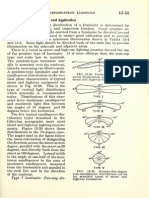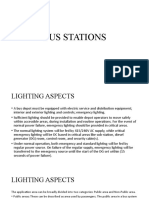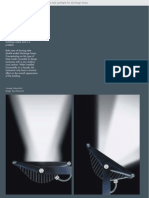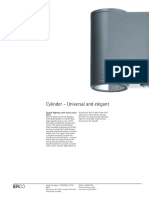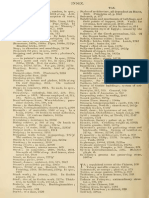0 ratings0% found this document useful (0 votes)
Handbook: Maximum
Handbook: Maximum
Uploaded by
reacharunkThis document discusses different types of street lighting luminaires based on their light distribution patterns. Type I has a symmetric distribution projecting light in opposite directions down the street. Types II-IV have asymmetric distributions of increasing width intended for lighting wider streets, with Type V having a symmetric distribution useful for center parkways. It recommends mounting heights for the different luminaire types based on lamp output. Color of light is noted to have little impact on visibility when light output and distribution are equal. Design considerations for street lighting include traffic density, accident history, and vehicle type and speed.
Copyright:
© All Rights Reserved
Available Formats
Download as PDF, TXT or read online from Scribd
Download as pdf or txt
Handbook: Maximum
Handbook: Maximum
Uploaded by
reacharunk0 ratings0% found this document useful (0 votes)
This document discusses different types of street lighting luminaires based on their light distribution patterns. Type I has a symmetric distribution projecting light in opposite directions down the street. Types II-IV have asymmetric distributions of increasing width intended for lighting wider streets, with Type V having a symmetric distribution useful for center parkways. It recommends mounting heights for the different luminaire types based on lamp output. Color of light is noted to have little impact on visibility when light output and distribution are equal. Design considerations for street lighting include traffic density, accident history, and vehicle type and speed.
Original Description:
hkhkhkh
Original Title
LH(502)
Copyright
© © All Rights Reserved
Available Formats
PDF, TXT or read online from Scribd
Share this document
Did you find this document useful?
Is this content inappropriate?
This document discusses different types of street lighting luminaires based on their light distribution patterns. Type I has a symmetric distribution projecting light in opposite directions down the street. Types II-IV have asymmetric distributions of increasing width intended for lighting wider streets, with Type V having a symmetric distribution useful for center parkways. It recommends mounting heights for the different luminaire types based on lamp output. Color of light is noted to have little impact on visibility when light output and distribution are equal. Design considerations for street lighting include traffic density, accident history, and vehicle type and speed.
Copyright:
© All Rights Reserved
Available Formats
Download as PDF, TXT or read online from Scribd
Download as pdf or txt
0 ratings0% found this document useful (0 votes)
Handbook: Maximum
Handbook: Maximum
Uploaded by
reacharunkThis document discusses different types of street lighting luminaires based on their light distribution patterns. Type I has a symmetric distribution projecting light in opposite directions down the street. Types II-IV have asymmetric distributions of increasing width intended for lighting wider streets, with Type V having a symmetric distribution useful for center parkways. It recommends mounting heights for the different luminaire types based on lamp output. Color of light is noted to have little impact on visibility when light output and distribution are equal. Design considerations for street lighting include traffic density, accident history, and vehicle type and speed.
Copyright:
© All Rights Reserved
Available Formats
Download as PDF, TXT or read online from Scribd
Download as pdf or txt
You are on page 1/ 1
13-36 I E S LIGHTING HANDBOOK
tribution. Intended for mounting approximately over the center of a
street. It projects two beams of light in opposite directions along the
street, their axis being parallel with the curb line.
Type II luminaire: narrow asymmetric distribution. Intended for
mounting at or near the side of a street. It has a narrow distribution,
having a lateral width up to 25 degrees in the cone of maximum candle-
power at approximately 75 degrees.
Type III luminaire: medium width asymmetric distribution. Intended
for mounting at or near the side of the street, has a lateral width up to
45 degrees in the cone of maximum candlepower at approximately 75
degrees. It is intended for wide streets.
Type IV luminaire: wide asymmetric distribution. Still wider laterally
than type III. The width is approximately 90 degrees in the cone of
maximum candlepower at approximately 75 degrees.
Type V luminaire: symmetric distribution. Candlepower in the
75-
degree cone is the same throughout 360 degrees. It is useful where light-
ing must be installed in center parkways and to some extent for intersec-
tions.
Mounting height
of
luminaires. The recommended mounting heights
for luminaires having the distribution characteristics described above
are given in Table 13-6. Where practicable, higher mounting may often
be preferable.
Table 13-6. Recommended Mounting Heights for Typical Street and
Highway Luminaires
LAMP OUTPUT
(lumens)
MOUNTING HEIGHT (feet) OF LUMINAIRE TYPE
I II III IV and V
2,500
4,000
6,000
10,000
15,000
25
25
25
20
25
25
30
20
25
25
30
30
20
25
25
25
30
Color of Light
Researches have shown that in general the visibility of objects on or
near the roadway is substantially the same throughout even the wide
differences in color of light from sodium-vapor, mercury-vapor, and fila-
ment lamps, when the comparison is on the basis of equal light output
and similar distribution.
Design Considerations
In the preparation of recommendations for street and highway lighting
all of the following important factors applicable to the specific problem
should be carefully evaluated:
1. Traffic density (vehicular and pedestrian).
2. Accident experience.
3. Type and speed of vehicles.
You might also like
- LightTools Street Light Type I - II - II - IV - V - VINo ratings yetLightTools Street Light Type I - II - II - IV - V - VI3 pages
- LED Lighting Distribution Types: Quick Reference Guide Type INo ratings yetLED Lighting Distribution Types: Quick Reference Guide Type I2 pages
- How To Design Efficient Street Lighting - (Part-3)No ratings yetHow To Design Efficient Street Lighting - (Part-3)8 pages
- Street Lighting Design and CalculationsNo ratings yetStreet Lighting Design and Calculations39 pages
- How To Design Efficient Street Lighting - (Part-3)No ratings yetHow To Design Efficient Street Lighting - (Part-3)17 pages
- K. K. Wagh Polytechnic, Nashik-3: Department of Electrical EngineeringNo ratings yetK. K. Wagh Polytechnic, Nashik-3: Department of Electrical Engineering20 pages
- K. K. Wagh Polytechnic, Nashik-3: Department of Electrical EngineeringNo ratings yetK. K. Wagh Polytechnic, Nashik-3: Department of Electrical Engineering20 pages
- Moldcast Contra Cline Series Brochure 1997100% (1)Moldcast Contra Cline Series Brochure 199718 pages
- Street Lighting, SL: Electrical Service RequirementsNo ratings yetStreet Lighting, SL: Electrical Service Requirements18 pages
- McGraw-Edison Area Lighting Division Product Catalog 1972100% (1)McGraw-Edison Area Lighting Division Product Catalog 197284 pages
- 21EEE01 Utilization & Conservation of Electrical EnergyNo ratings yet21EEE01 Utilization & Conservation of Electrical Energy24 pages
- What Is Fixture's Beam Angle & Beam Diameter (Part-1) : Electrical Notes & ArticlesNo ratings yetWhat Is Fixture's Beam Angle & Beam Diameter (Part-1) : Electrical Notes & Articles7 pages
- Street Lighting Design - Layout & Calculations - Electrical4U100% (1)Street Lighting Design - Layout & Calculations - Electrical4U26 pages
- Information Sheet 5.2-5 Track Lights Learning ObjectivesNo ratings yetInformation Sheet 5.2-5 Track Lights Learning Objectives4 pages
- Concept: Roland Jéol Design: Roy Fleetwood: NightscapeNo ratings yetConcept: Roland Jéol Design: Roy Fleetwood: Nightscape16 pages
- Traffic Engineering Unit 5 Road EnvironmentNo ratings yetTraffic Engineering Unit 5 Road Environment13 pages
- The Lamp Base - A Guide to Lamp Groups, Wiring, Styles and MaterialsFrom EverandThe Lamp Base - A Guide to Lamp Groups, Wiring, Styles and MaterialsNo ratings yet
- Young Uzbeks are finding new markets for traditional handicrafts online _ CNN BusinessNo ratings yetYoung Uzbeks are finding new markets for traditional handicrafts online _ CNN Business8 pages
- General Terms and Conditions of The Pzu NNW (Personal Accident Insurance Pzu Edukacja InsuranceNo ratings yetGeneral Terms and Conditions of The Pzu NNW (Personal Accident Insurance Pzu Edukacja Insurance19 pages
- And Rome.: in Front of The Prostyle Existed atNo ratings yetAnd Rome.: in Front of The Prostyle Existed at1 page
- The The Jamb The Name Much The: Tlio CL - AssesNo ratings yetThe The Jamb The Name Much The: Tlio CL - Asses1 page
- University Physics III - Optics and Modern Physics100% (1)University Physics III - Optics and Modern Physics630 pages
- Electron Probe Microanalysis - Scanning Electron Microscopy Epma - SemNo ratings yetElectron Probe Microanalysis - Scanning Electron Microscopy Epma - Sem29 pages
- Model Photo Specification: Los Precios No Están Obligados A Pedir Cantidades MínimasNo ratings yetModel Photo Specification: Los Precios No Están Obligados A Pedir Cantidades Mínimas2 pages
- B.Tech First Year Scheme & Syllabus (Common For All Streams - Academic Session 2019-20 Onwards)No ratings yetB.Tech First Year Scheme & Syllabus (Common For All Streams - Academic Session 2019-20 Onwards)6 pages
- 14OTC103002 OptiX BWS 1600G V100R002 System Description ISSUE1.20No ratings yet14OTC103002 OptiX BWS 1600G V100R002 System Description ISSUE1.2037 pages
- 74 Vios / Yaris: Headlight (Except Projector Type) (S/D From Aug. 2018 Production)No ratings yet74 Vios / Yaris: Headlight (Except Projector Type) (S/D From Aug. 2018 Production)1 page
- Angels Dont Play This HAARP by Nick Begich 19970% (1)Angels Dont Play This HAARP by Nick Begich 19972 pages
- 3mm White High Flux LED (HF3-W5570) - Component LEDs - Super Bright LEDsNo ratings yet3mm White High Flux LED (HF3-W5570) - Component LEDs - Super Bright LEDs3 pages
- Some Considerations For Selection and Successful Application of Surface Geophysical MethodsNo ratings yetSome Considerations For Selection and Successful Application of Surface Geophysical Methods13 pages
- Real-Time Remote Fiber Monitoring SystemNo ratings yetReal-Time Remote Fiber Monitoring System4 pages





